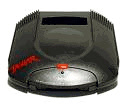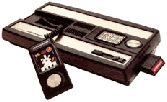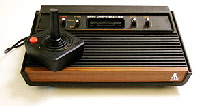




A Quick Bit of History
Atari, one of the most influential of all video game companies and often credited with starting the video arcade revolution. Although it did not make the first arcade game, it created the first commercially successful one. It was 1972 when a strange box appeared in bars called Pong. A simple ball and paddle game, that caught peoples imagination. In 1975 the home version of Pong appeared and it connected to your television and didn’t require a quarter to play. It was not the first home video game, it was the one that people latched onto and is ultimately responsible for the modern video game consoles acceptance.
In 1977 the Atari 2600 or Atari VCS as it was originally know was launched. Quickly
cornering the home video game market, until 1980 when Mattel introduced Intellivision,
which claimed it had superior graphics capabilities relative to the 2600. It actually
did, but Mattel focused more on sports games that could utilize there keypad. The
2600 did remain as the standard-
It is possible that you have never played an Atari game but you have probably heard the name. This article started out as a simple review of the Atari Flashback consoles but expanded to include other Atari licensed TV game systems and a bit of Atari history. This article centers around the Atari 2600 or VCS (Video Computer System) consoles rather than the games made for it. Use the combo box to get started or use the menu at the top right of every page.




Then in 1989 Atari released the Atari Lynx, a handheld console with color graphics, to critical acclaim worldwide. Yet the public never adopted this hand held gamming unit. So in 1993, Atari released its last console and the first 64 bit video game console the Atari Jaguar. The Jaguar failed, my understanding is that a large part of its failure was due to the complex programming needed, so many third party developers didn’t or couldn’t make games for it. What ever the reason the Jaguars failure was also to be the end of Atari.

just didn't get the right game mix or were concentrating in the wrong areas. Other systems were too expensive or poorly marketed and just fell away. The next generation of home video consoles brought new players into the market and some of the top arcade game manufacturers were to be amongst these future waves. In 1982 Atari released the 5200 based on its 400/800 home computer systems and designed to compete with Intellivision and the new Colecovision. It was a more advanced system than both but never managed to get the commercial success..
It was was 1985 when Atari decided to re-
Atari was eventually sold off and the brand and intellectual properties bounced from
company to company, with licensed products appearing from time to time. The Atari
brand was revived again on Dec 6, 2000 when 51.2 percent of the Atari Brand and intellectual
properties were acquired from Hasbro in a "long-







In 1984 the market had become saturated with home systems and cheap games. Home computers were also eating away at the console market and many consoles disappeared. Atari had its share of bad luck too, it overproduced games, made some bad conversions from arcade games and made a few Licensed games that just didn’t make sense or simply just bad (E.T.). Strangely most of these were made for the Atari 2600 which was still a popular console with a loyal following. Partially due to the large number of games available and third party companies like Activision and Imagic creating spectacular games for the modest machine.


Through out the 1980's and early 1990’s Atari produced a series of 8 bit home computers that were competing mainly with the Commodore series of home computers and to a lesser extent Apple. Atari had also continued to make video Arcade games whose days were also numbered..
After the acquisition of the Atari brand and properties Infogrames proceeded to re-
